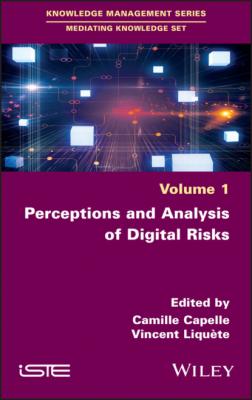Perceptions and Analysis of Digital Risks. Группа авторов
Читать онлайн.| Название | Perceptions and Analysis of Digital Risks |
|---|---|
| Автор произведения | Группа авторов |
| Жанр | Базы данных |
| Серия | |
| Издательство | Базы данных |
| Год выпуска | 0 |
| isbn | 9781119887942 |
Table of Contents
1 Cover
4 Foreword The notion of risk Digital risks and the context of education Risk perception Educational response and research
6 PART 1 Risk Perceptions, Education and Learning 1 Digital Risks: An Obstacle or a Lever for Education? 1.1. Introduction 1.2. Digital risks and education: what are we talking about? 1.3. Questioning perceptions of digital risks among new teachers 1.4. Teachers’ perceptions of digital risks 1.5. Reflection on the role of digital risk representations in education 1.6. Conclusion 1.7. References 2 Teenagers Faced with “Fake News”: Perceptions and the Evaluation of an Epistemic Risk 2.1. Introduction 2.2. Fake news: from production to reception 2.3. Methodological framework of the study 2.4. Results of the study 2.5. Discussion of the results and reflections on media and information literacy 2.6. Conclusion 2.7. References 3 “A Big Nebula that is a Bit Scary” (Louise, Trainee Schoolteacher): Training through/in Digital Technology, in School and in Professional Training 3.1. Social beings, above all else 3.2. Understanding of digital technology in the classroom 3.3. Teaching with and through digital technology: Constant risks 3.4. Potential courses of action 3.5. References
7 PART 2 Risks in the Light of Socio-Economic Issues 4 Top Managers Confronted with Information Risks: An Exploratory Study within the Telecommunications Sector 4.1. Introduction 4.2. Information risk: the conceptual field 4.3. Controlling information risks: Security policy 4.4. Information risk and management 4.5. Study methodology and the stakeholder group 4.6. Information risk: The perspective of top telecoms managers 4.7. Conclusion 4.8 Acknowledgments 4.9. References 5 Cell Phones and Scamming Risks in Cameroon: Users’ Experiences and Socio-Institutional Responses 5.1. Introduction 5.2. Mechanisms behind cell phone scamming in Cameroon: exhibiting credulity 5.3. The dynamics of cell phone use in Cameroon 5.4. Socio-institutional governance of cell phone use in Cameroon: Optimal or approximate mediations? 5.5. Conclusion 5.6. References
8 PART 3 Digital Risks: Practices and Mediation 6 Towards a Normative Prescription of Information Practices on Digital Social Networks: A Study of Documentary Pedagogical Projects in Middle School 6.1. Introduction 6.2. Contextualization of risk 6.3. Issues to consider 6.4. Research objects 6.5. Research protocol 6.6. Risk regarding DSNs in the pedagogical approach 6.7. Discovering DSNs in a school context: Dealing with risks 6.8. Perspectives for an information culture 6.9. Conclusion 6.10. References 7 MIL as a Tool for Teachers to Prevent Risk and Transmit Digital Culture 7.1. Studying digital technology in schools from the perspective of teachers’ representations 7.2. What do digital and media literacy evoke in teachers? 7.3. The contours of media and information literacy according to teachers 7.4. What does the requirement to transmit digital culture mean for teachers? 7.5. Conclusion 7.6. References
9
